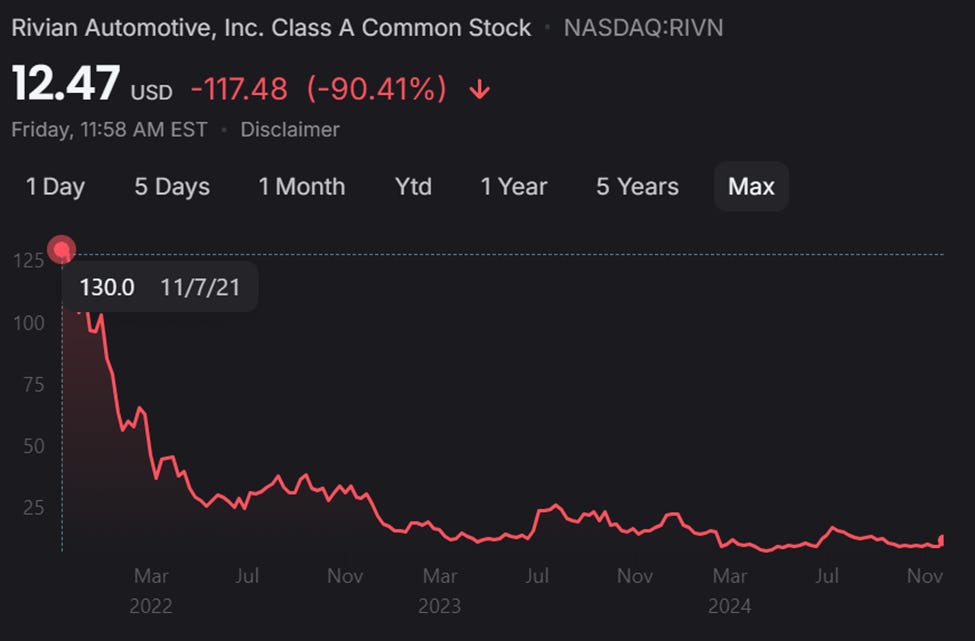The Biden administration knows its “signature” climate tax breaks and subsidies are on the line. That’s why it’s doled out a staggering $6.6 billion loan to EV maker Rivian to build a factory in Georgia with the capacity to make 400,000 SUVs and crossovers. The plant is expected to begin operating in 2028, long after the Biden administration might be held responsible for their flagrant misuse of taxpayer funds.
It’s hard not to see Solyndras everywhere when the federal government repeatedly makes bad bets on green technology. Solyndra, a solar panel manufacturer, was awarded a $535 million loan guarantee from President Barack Obama’s Department of Energy. Despite glaring red flags, the president touted the company for “leading the way toward a brighter and more prosperous future.” By Sept. 1, 2011, Solyndra had failed, fired all of its employees, and filed for bankruptcy.
Rivian went public in 2021 and its valuation surged to $120 billion, having at the time only “sold a mere 156 vehicles despite being in business for 12 years.”
Here’s how that’s going. In November 2021, the stock sold for $130 a share. This week, the stock stands at $12.47 a share. It’s down 90 percent since it went public. EV true believers, now might be a good time to buy low — though the chance to “sell high” may never come back around.
The Wall Street Journal editorial board reminds us just how bad of a bet Rivian has been, despite ample subsidies:
Investors may have been betting on government subsidies supercharging Rivian’s growth, and they can’t blame the Biden Administration for not delivering. The Inflation Reduction Act includes a $7,500 tax credit per vehicle for EV buyers, plus a $40,000 credit for commercial EVs. The latter is a particular boon for Amazon, that corporate pauper, which owns shares representing 14.8% of Rivian’s voting power and has agreed to buy up to 100,000 of its delivery vans. The IRA also includes hefty subsidies for domestic battery production.
Despite these giant subsidies, Rivian lost about $4 billion on the 37,396 vehicles it has sold during the first nine months of this year. That’s $107,043 a vehicle. Ford loses only about $51,000 on each EV sold.
But unlike traditional auto makers, Rivian can’t use profits from gas-powered cars to subsidize EVs. Thus the company is rapidly burning through cash. It has suffered repeated assembly disruptions and had to recall vehicles to fix defects. It has $1.25 billion in debt due in 2026, so its current spending pace is problematic…
Rivian warns in its latest earnings statement that industry competition will intensify owing to government subsidies, new entrants, auto-maker discounts and a “regulatory push for alternative fuel vehicles…”
Even Rivian seems to harbor doubts about its future. It warns that current and potential competitors have “significantly greater financial, technical, manufacturing, marketing, or other resources.”
A cherry on top: the loan agreement is conditional on Rivian “not actively” opposing “union organizing efforts at the Georgia plant.”
Since the loan is conditional, it may be possible for the incoming Trump administration to scrap it. If not, it’ll be one more Biden-era subsidy that taxpayers are paying for long after the administration is out of office and the company has gone bankrupt. $6.6 billion will make Solyndra’s $535 million look measly.
This piece was originally published at Center of the American Experiment.





Nicely done, thank you. In my mind, there is no doubt to the answer to your paramount question.
The federal government is guilty of Racketeering at all times with stuff like this. The Deep State term mostly surrounds the intel communities, but this is no different: forcibly taking taxpayer monies and giving it to your benefactors.